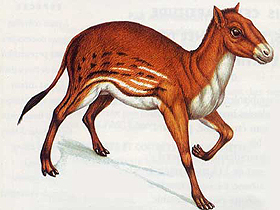
Evolutionists have set out horse fossils out in a series, from small to larger. Yet evolutionists do not agree on regarding these family trees concerning the horse’s supposed evolution. The only point they agree upon is their belief that a dog-like mammal known as Eohippus (Hyracotherium) that lived in the Eocene period 55 million years ago is the first forerunner of the horse. Yet Eohippus, portrayed as an equine ancestor that became extinct millions of years ago, is almost identical to the mammal known as Hyrax that still lives in Africa, but has not the slightest connection with horses.147
The invalidity of the claim regarding the evolution of the horse is becoming clearer every day with the discovery of new fossils. Eohippus has been identified in strata containing some fossilized breeds of horse—Equus nevadensis and E. occidentalis—that are still alive today—Equus nevadensis.148 This shows that the modern horse lived at the same time as its supposed forebear, proving that the horse never underwent the process known as evolution.
But perhaps the most serious weakness of Darwinism is the failure of paleontologists to find convincing phylogenies or sequences of organisms demonstrating major evolutionary change. . . The horse is often cited as the only fully worked-out example. But the fact is that the line from Eohippus to Equus is very erratic. It is alleged to show a continual increase in size, but the truth is that some variants were smaller than Eohippus [the first in the sequence], not larger. Specimens from different sources can be brought together in a convincing-looking sequence, but there is no evidence that they were actually ranged in this order in time.149
All these facts reveal that the horse evolution-trees, portrayed as one of the strongest pieces of evidences for evolution, are imaginary and worthless. Like other species, horses were brought into being with no evolutionary forebears. (See Origin of the Horse, the.)
147 Francis Hitching, The Neck of the Giraffe: Where Darwin Went Wrong, pp. 16-17, 19.
148 Ibid.
149 Gordon Rattray Taylor, The Great Evolution Mystery, London: Sphere Books, 1984, p. 230.


